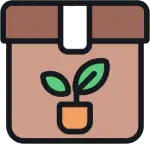Comprehensive Checklist for Moving with Houseplants
Relocating to a new home within the US can be a rewarding experience, but for plant enthusiasts, it requires extra care to keep your indoor greenery safe from stress, damage, or loss. Houseplants are sensitive to temperature shifts, light variations, and physical handling, so a well-thought-out plan is essential. This detailed checklist, informed by relocation experts at A Better Moving, founded in 2007 by Frank Martin, guides you through preparation, packing, transport, and acclimation. Whether it’s a short-distance move or across states, these steps will help your plants arrive healthy and ready to flourish in their new space.

Pre-Move Preparation: Evaluate and Condition Your Plants
Begin 4-6 weeks early to assess and strengthen your collection for the journey ahead.
- Inventory Your Plants: List each plant by species, size, and specific care needs (e.g., humidity, light preferences). Identify fragile or large ones that might need special arrangements, like gifting or temporary care with friends.
- Check Health and Treat Issues: Inspect for pests, diseases, or weaknesses. Apply treatments if needed, and avoid fertilizing close to the move to prevent additional stress.
- Research Regulations: Some states have rules on plant transport to prevent pest spread (e.g., California’s checkpoints). Use USDA resources to check for required permits or inspections for interstate moves.
- Collect Supplies: Gather boxes, plastic pot wraps, bubble wrap, packing paper, and supports like bamboo stakes. Opt for breathable materials to allow air circulation.

Packing Stage: Protect and Stabilize
Secure packaging minimizes shock during transit.
- Water and Prune Wisely: Hydrate moderately 2-3 days before to keep soil moist without sogginess. Trim excess growth or dead parts to reduce weight and encourage regrowth.
- Wrap Pots Securely: Cover pots with plastic bags to contain soil, then pad with foam or newspaper. For tall plants, stake stems and wrap loosely in soft fabric.
- Box with Care: Group small plants in divided boxes with cushioning. Leave space for air—don’t seal tightly; add ventilation holes. Label as “Live Plants – Fragile – This Side Up” with notes like “Keep Cool.”
- Decide on Transport Method: Sensitive plants do best in your vehicle for controlled conditions. If using pros, confirm with A Better Moving for plant-friendly options.

Moving Day: Monitor Environmental Factors
Focus on maintaining stable conditions throughout the trip.
- Temperature Control: Aim for 50-70°F (10-21°C); avoid hot cars or cold trucks. Use blankets for insulation in varying weather.
- Light and Ventilation Management: Shield from direct sun to prevent burns, but provide indirect light. Ensure airflow without exposure to strong drafts.
- Hydration Checks: Mist leaves on long hauls if dry; stop to monitor for wilting and adjust positioning as needed.

Post-Move Acclimation: Revive and Adjust
Help your plants settle into the new environment promptly.
- Unpack Right Away: Remove from boxes first, placing in a shaded, stable spot. Check for transit damage.
- Gradual Introduction: Slowly expose to the home’s light and humidity over a week to avoid shock. Quarantine if pests are suspected.
- Repot as Necessary: If roots or soil are disturbed, repot with fresh mix. Delay fertilizing until recovery signs appear.
- Ongoing Care: Observe for stress like leaf drop; resume regular watering and positioning based on needs.
Following this checklist makes moving with houseplants straightforward and successful. For professional assistance with your US relocation, including advice on living items, trust A Better Moving, established in 2007 by Frank Martin. Your green companions deserve the best care!
Ready to keep your greenery thriving on the move? Download our free PDF checklist for relocating with houseplants now and ensure a seamless transition for your leafy friends!
